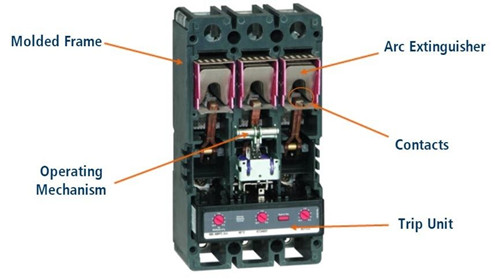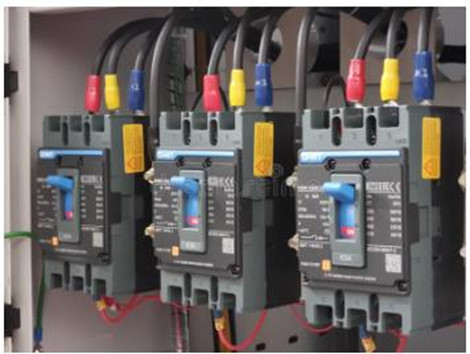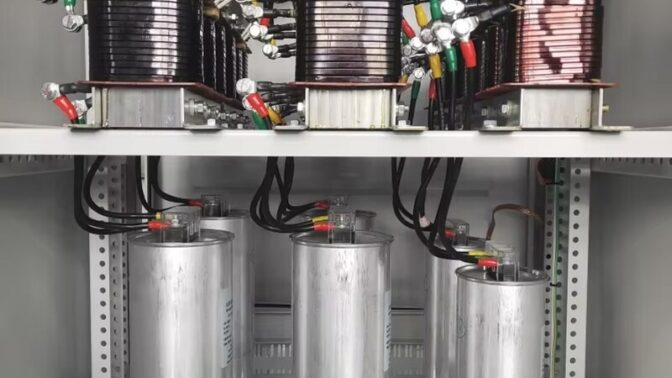24-12-2025
Molded Case Circuit Breaker - Definition and Function
Molded-shell circuit breaker is a type of electrical protection device commonly used when the load current exceeds the capacity of miniature circuit breaker. They are also used in applications of any current rating requiring adjustable trip settings, which are not available in plug-in circuit breakers and MCBs.
Molded case circuit breaker, MCCB for short, is a type of electrical protection device that can be used for a wide range of voltages and frequencies at both 50 Hz and 60 Hz. The main difference between a molded case circuit breaker and a miniature circuit breaker is that an MCCB can have a current rating of up to 2,500 amps and its stroke setting is usually adjustable. Another difference is that MCCB tends to be much larger than MCB. Like most circuit breakers, MCCBs have three main functions:
• Overload protection – currents higher than rated value last longer than is normal for the application.
• Protection against electrical failures – During a fault such as a short circuit or a line failure, there is an extremely high current that needs to be cut off immediately.
• Switching circuits on and off – This is a less common function of circuit breakers, but they can be used for that purpose if enough manual switches are not available.
The wide range of current ratings available from molded case circuit breakers allows them to be used in a wide variety of applications. MCCBs are available with current ratings that range from as low as 15 amps, to industrial ratings like 2,500 amps. This allows them to be used in both low power and high power applications.
Molded Case Circuit Breaker Operating Mechanism

At its core, the protection mechanism used by MCCBs is based on the same physical principles used by all types of thermo-magnetic circuit breakers.
• Overload protection is implemented by thermal mechanism. MCCBs have bimetallic contacts that expand and contract as the temperature changes. Under normal operating conditions, the contact allows current to flow through the MCCB. However, as soon as the current exceeds the adjusted stroke value, the contact will begin to heat up and expand until the circuit breaks. Thermal overload protection is designed with a time delay to allow short-term overcurrent, which is part of the normal operation of many devices. However, any overcurrent that lasts longer than normally expected indicates an overload and the MCCB is tripped to protect equipment and personnel.
• On the other hand, fault protection is realized by electromagnetic induction and instantaneous feedback. Fault currents must be interrupted immediately, no matter how short or long their duration. Whenever a fault occurs, the extremely high current creates a magnetic field in the solenoid coil located inside the breaker – this magnetic induction breaks a contact and the current is cut off. As an addition to the magnetic protection mechanism, the MCCB has internal arc dissipation measures to facilitate interruptions.
As with all circuit breakers, the MCCB includes a disconnect switch that is used to manually disconnect the breaker. It is used whenever power must be disconnected to perform field work such as maintenance or equipment upgrades.
Types of MCCB Circuit Breaker by Application

Molded-case circuit breakers can have very high current ratings, allowing them to be used in heavy duty applications. Following are some typical applications of MCCB:
• Mains protection – Power supply circuits that supply power to large distribution boards often have very high currents, hundreds of amperes. In addition, if more circuits are added to the system in the future, it may be necessary to adjust the interrupt settings of the circuit breaker. Therefore, a molded case circuit breaker is required.
• Capacitor Bank Protection – Capacitor banks are a very important component of commercial and industrial electrical systems, as they allow power factor correction – reducing line currents and preventing charges from electrical company. Large capacitors can have high currents and will require MCCB protection
• Generator Protection – Large generators can provide hundreds of amps of output. In addition, genomes are often very expensive. The high current rating of molded case circuit breakers allows them to provide reliable protection in this application.
• Welding applications – Some welders can generate very high currents beyond the capabilities of miniature circuit breakers, requiring the use of MCCBs
• Low current applications require adjustable trip settings – MCCBs aren't just for high current applications. There are models rated for less than 100 amps where low current equipment requires an adjustable trip setting powered by MCCB.
• Engine protection – MCCB's reliable protection makes them the right choice for motor protection. Molded-shell circuit breakers can be adjusted to provide overload protection without tripping when the electric motor's inrush current
In a nutshell, MCCBs provide adequate protection whenever an application requires a high current rating, an adjustable trip setting, or a combination of the two.



